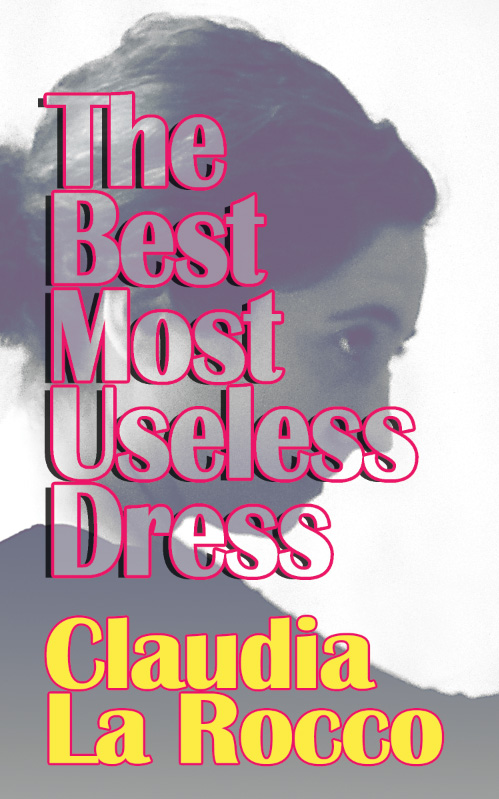Claudia La Rocco, The Best Most Useless Dress
Cherry Pickman

Claudia La Rocco’s The Best Most Useless Dress is not poetry. That is, it’s not poetry exclusively, but an amalgam of writings, including criticism, handwritten notes, musings, and bits of conversation (also, images) with any combination of these at times appearing within a single piece. The result of all this would be disorienting were it not for recurring themes and phrases, and, perhaps more importantly, the earnestness with which she approaches each poem and the general sense that she has eschewed the desire to provide the reader with something polished and perfect. This meandering, this hesitation, this doubling back creates an intimacy with the reader that excuses some of the haphazardness of the work—no, not excuses—justifies.
In a photocopied handwritten note (taken, as La Rocco explains in the credits, “in conversation with an in-progress dance by the choreographer Karen Sherman”), she writes, “If you take notes long enough, you will reveal everything about yourself.” But as the notes progress throughout the book, sometimes the handwriting is nearly illegible and the words threaten toward inscrutability; on page 107 she writes, “I forget how to take notes.” The revelation La Rocco initially set up is ultimately—and delightfully—undermined.
Similarly, her poems resist the neatly tied package. In both “Hinge and Straighten” and “Good Fortune” she asks, “Why do we repeat?” The repetition of this very question reveals the exploratory nature of La Rocco’s art—that things can be revisited and reinvented, and that the art is in the asking, not in the answers themselves. In fact, The Best Most Useless Dress asserts, over and over again through its wanderings, that paring away ambivalence in order to take a definitive stance is dishonest, and work that celebrates that kind of polished artifice is inherently less human. The closing poem in the collection, “The bad cat came and I chased him away,” reaffirms this: “I love you, though, cat. / It’s a new form of uncertainty.” The strength of the book lies very much, and very comfortably, in this place of uncertainty.
A willingness to be undefined is perhaps surprising coming from a critic. Many readers will be most familiar with La Rocco’s writing as a dance and performance art critic for, among others, the New York Times and Artforum. In light of this, we might expect something definitive, opinionated, or, in her own words, sometimes “cynical.” La Rocco hasn’t shied away from this duality here. It is but another layer of complexity. In “Forget About Your Paper Moon” she recalls that while watching a dance performance her “experience shifted from feeling caught up within the poetic vagueness of a live work to constructing, from a remove, intellectual hypotheses about it.” Which is better—being caught up in the “poetic vagueness” or being able to intellectualize, form opinions, and make sense of the thing—isn’t ever explicitly stated.
Later, in “She Said, He Said,” La Rocco offers a direct look into the art critic’s world, in all its tedious and cynical glory, when she pokes fun at Nancy Spector, chief curator of the Guggenheim Museum. She pulls a direct quote from Spector’s writing on Tino Sehgal’s performance work “The Kiss”: “This is visual art we’re talking about, period…Either you respect it or you don’t. It makes perfect sense to many of us.” This is the rigidity La Rocco seems soured by, and later in the piece confesses, “I am a hopeless grouch.” The tug-of-war that exists between artist and critic is magnified in La Rocco, who is both, and she’s keenly aware of it. In “Just go for it, go for it” she writes, “That’s what being in someone else’s eye will do to you.”
There is perhaps no artist more subject to “being in someone else’s eye” than the dancer, who is both vehicle and spectacle. In this collection, La Rocco poses dance and performance art as means of communication (to which poetry seems an apt counterpart). “On Taste,” which first appeared in The Miami Rail is a moving hybrid that recounts, in a nonlinear way, a collaborative dance performance that took place at the BFI Gallery in Miami. The multi-section piece closes with a single, contained poem—lines that seem to link dance and poetry inextricably: “You make sense without words,” then, the penultimate line, “There is a way in which the translator must love failure,” and finally, just when it seems the critic in La Rocco will have the last word, she closes with, “The thin line of light splitting the morning sky.” This isn’t the only poem that ends looking skyward. “The Missing World” finishes looking at the stars, and “More this, less that” leaves off with “jets roaring overhead.” Perhaps it would be reductive to call this optimism, but there is an openness that pervades the work, that rejects the single-mindedness that critics or tastemakers can sometimes cultivate. Because of this openness, La Rocco brings energy to the tired question, what is the function of art? Predictably, she refuses to answer. Instead, the reader is invited to put on her best, most useless dress to attend where there is “Nothing at stake. Everything.”
Cherry Pickman is the author of Theory of Tides, which was selected by Lucia Perillo for the Poetry Society of America’s New York Chapbook Fellowship. Her work has appeared in 32 Poems, Boston Review, and Indiana Review, among others.










